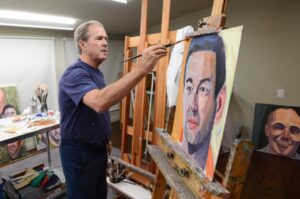
George Bush Jr

REACH is the name of a $250m expansion to the John F. Kennedy Center for the Performing Arts that opened in Washington, D.C. in September 2019. Sprawling south from the stately main hall is a new campus focused around a series of minimal concrete pavilions that appear discrete at first but are connected underground. The director calls the project “our collective moonshot” and the music director says “this belongs to you”, but I wonder: REACH for what? From where? Who is doing the reaching? And why the capital letters? Looped videos suggest many connotations of the name, such as the potential for art to reach our voices past barriers that seem impossible to surmount. But when I descended to the largest gallery at the REACH and discovered the first major exhibition there, appeals to romantic nostalgia and transnational solidarity rang hollow.
‘Portraits of Courage’, sponsored by Boeing, is a group of portraits ostensibly painted by President George W. Bush of post-9/11 combat veterans. Before getting to the politics of this patron/painter/painted situation, I must acknowledge that the paintings as art objects are bad. They are heavy-handed, uninspired, and childish, but not in the modern genius way. They reveal not true conviction or a real artistic impulse, but instead reflect the corrupt motives of the President-turned-painter and the lazy public who will happily digest propaganda as if it is comfort food. This is a fine example of painting as PR, and art museum as reputation laundry machine. Even more egregious is that the main conceit of the show is disregarded at the outset. The first paintings we see are not painted by Bush and are not paintings of veterans. Instead, they depict Bush himself – smiling, or shown from behind as he paints a puppy dog. Was the dog’s name Courage? Only after this vain prologue do we see portraits of actual veterans, interspersed with promotional videos advertising the Bush family non-profit and listing the achievements of their initiatives. To open a major new contemporary arts space with free advertising for a war criminal, funded by the military-industrial-complex titans who build the literal and metaphorical walls of violence that separate us? What gives? Nowhere is there any mention of Bush’s bungled role creating the wars that these veterans fought and were injured in, and when I spoke with a docent in disbelief about the paltry exhibition materials, I was directed to an official “PoC” app designed by the same team who made the Richard Nixon: Library Tour & Research app. If we are to read between the lines here, what are we to find? A deadpan ploy to use art and sympathy as a way of improving Bush and his family’s reputation.
It makes sense that the newest national arts center in America would be funded like this and feature paintings we will likely see in a Trump Hotel lobby or suite. President Trump’s Secretary of the Treasury Steven Mnuchin is the son of the powerful art dealer who recently bid $91m on Jeff Koons’ Rabbit, and Trump’s criminally ineffective Secretary of Education Betsy DeVos donated $1m of her family’s Amway pyramid scheme fortune to the REACH’s capital campaign. With a President in the White House more successful at building fraudulent brands and relying on violence and intimidation to get his way than governing, how can we be surprised that the REACH is a glorified place to host holiday parties for death merchants and an efficient tax write-off for the largest beneficiaries of our broken economy.
Before the exhibition came to Washington, D.C., ‘Portraits of Courage’ was shown near Mar-a-Lago in West Palm Beach, Florida, at a private art foundation with Bush-appointed officials on the board. There and here in Washington, this is easy art for elites, and if you fall for the suggestion that these paintings honor veterans or somehow make up for Bush’s blunders, then you don’t even need to look at the paintings to like them. In this way, art history jargon only obscures the sinister nature of what is really happening here. The failures of this show are the failures of the REACH, and should be a call to action more urgent than that of a bad art exhibition. For now, REACH does not stand for anything. This is not a community art space or egalitarian inspiration chamber. Each room is for sale to the highest bidder, and that includes the outdoor spaces. The Presidential Grove of gingko trees near the Boeing River Pavilion are thanks to the People of the United Arab Emirates, and the Reflecting Pool is thanks to the State of Qatar. Diplomatic ties with Saudi Arabia were not severed when the Saudi government assassinated a Washington Post journalist, and the official White House response was because the Saudis buy so many weapons from American companies. At the REACH, international networks of arms and arts are on full display. It is a bleached, glaring depot and reminder of what happens when murky funding, jingo-nationalistic propaganda, and the retold romanticism of art as trans-political all marry into an architecture of emptiness, shadow, and exclusion. I hope that future exhibitions and programming in these spaces realize inaugural missteps and attempt to steer the ship in a new direction.
Max Levin
Volume 34 no 3 January – February 2020 pp 26-27

